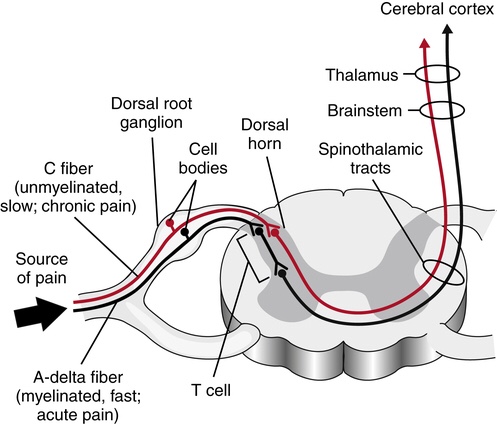* Music boosts your IQ and EQ. Try my favorite music before reading this article
*Overall information:
-The spinothalamic tract is an ascending pathway of the spinal cord. It is responsible for carrying pain, temperature, pressure and crude touch from our skin surface to the thalamus in the brain before reaching the primary sensory cortex. It is composed of:
+Anterior spinothalamic tract: carries crude touch and pressure sensation
+Lateral spinothalamic tract: carries pain and temperature

-The spinothalamic tract will use three neurons to send sensory information to the brain (pseudounipolar neurons, substantia gelatinosa, nucleus proprius)
*How sensory information is transmitted from our skin to the brain?
-Tissue damage and extreme temperature will activate the nociceptor (a special type of receptor that picks up sensory information). There are 2 types of neurons that are extend from the nociceptor to the dorsal grey horn:
- A delta fibers: they are stimulated by mechanical stimuli and cold temperature. These fibers are large axons that send fast pain
- C fibers: they are stimulated by hot temperature, mechanical and chemical stimuli. These axons transmit slow, annoying, aching pain that may result from inflammation.
- Merkel’s discs, peritretial nerve endings, free nerve endings: these fibers respond to crude touch and pressure


-All of these fibers will synapse on the pseudounipolar neurons (first order neuron) which are located within the dorsal root ganglion before entering the spinal cord where these fibers will synapse within the secondary neurons: the substantia propria or the nucleus proprius (both of them are grey motor structure because they contain low concentration of myelin surrounding the nerve cells and contain rexed laminae)
+C fibers will pick up the stimulus, go through the pseudounipolar neurons which are located within the dorsal root ganglion toward the spinal cord. At this point, they will synapse on rexed laminae 2 and 3 before crossing to the contralateral side (passing anterior white commissure) and then ascending upwards (forming lateral spinothalamic tract).
+A delta fibers will pick up the stimulus and go through the pseudounipolar neurons. They will synapse on rexed laminae 1 and 5 before crossing to the contralateral side and then ascending upwards (forming lateral spinothalamic tract).

+Other receptors that pick up crude touch and pressure also go through the pseudounipolar neurons. Researchers believe that they will synapse on rexed laminae 3,4 or 5 before crossing and ascending upwards (forming anterior spinothalamic tracts).
-When ascending upwards, anterior spinothalamic tracts will fuse in (forming spinal lemniscus) and go directly to the thalamus. They then go to the sensory cortex.
– Fibers of the lateral spinothalamic tracts will go through the medulla. Most C fibers will terminate on the reticular formation, forming a spino reticular tract (piece of grey matter that extends to all parts of the brainstem, responsible for the alertness wakefulness of the entire system) while some of them will travel to the thalamus. From here, these fibers will synapse on the nuclei inside the thalamus and then radiate to supply different cortex, cingulate gyrus, and insular cortex (stimulate emotional reaction) . Additionally, C fibers will also give off collaterals to
+The superior colliculus which is located in the pon section of the brainstem (spinotectal tract) will control our face expression and eye movements.
+The parabrachial nucleus (spinomesencephalic tract) which will then send axons to the amygoda (a structure that is associated with fear, pressure, painful aspect, anger)
+The periaqueductal grey matter which controls descending pain modulation pathways
+The hypothalamus (spino hypothalamic tract) which controls autonomic responses.
-On the other hand, most of A delta fibers will travel to the thalamus, synapse on ventral posterior lateral and some of them will be sent to the reticular formation. From the thalamus, fibers will be sent to the somatosensory cortex.
-In the thalamus, crude touch and temperature sensation will synapse on the third order neurons which are thalamic nuclei (most of them synapse on ventral posterior lateral) and stimulate emotional reaction.